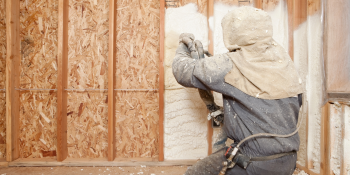Q&A Forums
how much closed cell foam? Post New Topic | Post Reply
| Author | Comments |
|---|---|
|
dpschuste
Posted: Dec 02, 2017 02:58 PM
|
how much closed cell foam?
I live in south central PA--zip 17349. My zone map says I should have R38 on the cathedral ceiling. My spray foam contractor says 4" of cc is plenty to do the job--beyond 4" there is no benefit. Is this enough? I am particularly worried about condensation in the ceiling, as I've had that in a prior, badly insulated home.I would appreciate any advice! |
|
mason
Posted: Dec 02, 2017 04:15 PM
|
While I agree with your contractor that 4 inches of closed cell foam would provide adequate insulation in your area for both insulation performance and condensation control, building codes require the R 38. So, it is up to your building code official to determine what is required. Make sure you provide him with data that shows the value of the foam. There are many studies showing performance of SPF compared to fiberglass. SPFA when I was Director of the organization compared the performance of closed cell SPF installed to the underside of the Roof deck to R 38 of fiberglass installed to a floor of an attic at the Oakridge National Laboratories Attic simulator. The results showed that the foam performed equal or better than the fiberglass. Email me at masonknowles@aol.com and I can forward the study along with other articles about the diminishing returns of R value. |
|
mark moyer
Posted: Dec 03, 2017 02:20 PM
|
if installed properly you shouldnt have condensation issues in this assembly. is it enough? you cant put in less and expect more. code works,,the numbers are there for a reason. foam to code and you will have performance that far exceeds the codes "mimimum rvalue". think about what minimum is....the majority of homes,,,energy star and all the other bells,whistles and titles..have the least amount "recomended"...least...priceless.. think that 40% of the USA energy used is in the heating and cooling of buildings...but minimum aint getting us there. there are real solutions. they come with a cost, and you cant beat cheap. a guess would be that your R25 cc foam in the cathedral will perform like the r38 batt hung,,guess not a promise..rofl we prefer to install as much foam as we can in the assembly sometimes open cell foam is a good fiscal option,,obtaining the same results when applied to appropriate depths. and what is that depth..we like to use code minimum,,as a start.. as stated above this application will far exceed the traditionally insulated code compliant structure.... consider,,you are building for the next 100 yrs,,costs to operate will not go down.. put in more if you have the room and the budget... if your cathedral is 2x6,,pay to have em put 5" +/- 1/2" closed cell in it..will work dandy. i scratch my head when i hear reference to the spfa study mentioned. lets see...compare apples to oranges...yeah,,,garbage in = garbage out. flat lid assembly fiberglass compared to a conditioned lid assembly. so you add conditioned space,,use the same design and mechanical paramaters and say this a study of equal performance..??? adding the conditioned space in the conditioned lid assembly, it would seem this may show greater performance. the same mechanicals are conditioning more space for the same amount of energy used. just never could make sence out of how they set this study up. maybe a conditioned fiberglass assembly compared to conditoned foam assembly or a flat lid fiberglass assembly compared to a foam sealed flat lid assembly ,,,it hurts when i think,,, |
|
mason
Posted: Dec 04, 2017 02:05 PM
|
Hate to disagree with you but the data is very reliable. I set up the study because that is where you place fiberglass in the attic so it is comparing real world applications. Consider that the study did not take into consideration air infiltration which can add a great amount of energy loss. I have been in the foam business more than 47 years and my opinion is based on not only research but also field data and personal observations After a certain point that varies depending on the climate, additional insulation is almost meaningless. Once you get past 4 - 5 inches of closed cell foam, very little insulation value is added even under the most extreme climates. For example the most we ever placed in a freezer operating at -20 F in a very hot climate (South Texas, 100 degrees for 3 months at a time) was 5 inches in the ceiling and floors and 4 inches in the walls. The key is making the building as air tight as possible then letting the foam do its thing. |
|
mark moyer
Posted: Dec 05, 2017 12:21 AM
|
hold on mason,,,the study should have put the foam on the flat lid as well,,,3-4" open cell and then blown fiber over foam to obtain equivalant rvalues as the fiberglass assembly(no, i do not seal a flat lid with closed cell,,and i have my reasons,,but they too are wrong imma guessin)...this is the typical application nowadays.... it would seem that this would be a more similar comparison of applications: flat lid insulation to flat lid insulation,,,(the air seal be damned here,,you are showing equal rvalues in this study,,not the air seal or you would have incorporated blower door data in this study,,,but we werent there then were we?). then the study could show a conditioned lid assembly of foam of equal rvalue to to conditioned lid of fiberglass,,how ever they get there. dense pack over netting, batts with air space above,,the foam will blow them away. thank you for your 47 years, you know i respect your opinion and fall back to it regularly. i too have been in this a bit. not my moms condo. forgive me not a single roof that i care to put my name on, 90% residential custom home interior spray foam. we have data as well you have had closed cell blinders on for some time. this is not about potatoe sheds,,,coolers or commercial.. this is about residential insulation and the use of spray foam. open cell or closed cell. this study is fudged up compared a flat lid fiber to flat lid foam and a conditioned lid fiber of all the varying types to an oc an a cc conditioned lid assembly and then we may have some data to show our builders and homeowners why they should spend the expray 30%. this is where our professional organizations have left us down. please keep the dialoge going.. |
|
beringstar
Posted: Jan 03, 2018 01:46 AM
|
Mark. Dealing with the prescribed R value (code book) and the right performance thickness using closed cell is a common problem in any municipality, including here in Kansas City, MO. R38 is the prescribed general value in the 2012 code on a vault. However, I utilize energy modeling to take the whole assembly into consideration to provide a better assessment. This modeling process is both acknowledged in the code as a performance based method, and is accepted by your city. But you need to find out what reports they acknowledge. Find a guy or gal who does energy modeling. They assign a U-value to each member of the building assembly, look at windows, orientation of the structure, etc. I usually see R values of R26-28 for a roofline using closed cell, in which case 4-4.5 inches works and meets the inspection and code. And that is enough closed cell. |
|
beringstar
Posted: Jan 03, 2018 01:48 AM
|
Also note that R1102.2 allows for a reduction of R value from R38- R30 on up to 500 sq feet, which covers a lot of small projects without the hassle . |
|
beringstar
Posted: Jan 03, 2018 01:51 AM
|
your municipality may adopt different things from the code book. A trip downtown to meet and discuss these things with the person who is in charge of managing city inspections is a wise move for any contractor. develop the relationship, let him or her know that you are wanting to meet code and satisfy expectations but still sell a job. |
|
beringstar
Posted: Jan 03, 2018 01:51 AM
|
your municipality may adopt different things from the code book. A trip downtown to meet and discuss these things with the person who is in charge of managing city inspections is a wise move for any contractor. develop the relationship, let him or her know that you are wanting to meet code and satisfy expectations but still sell a job. |
|
beringstar
Posted: Jan 03, 2018 01:51 AM
|
your municipality may adopt different things from the code book. A trip downtown to meet and discuss these things with the person who is in charge of managing city inspections is a wise move for any contractor. develop the relationship, let him or her know that you are wanting to meet code and satisfy expectations but still sell a job. |




























